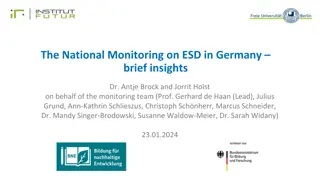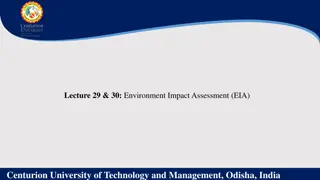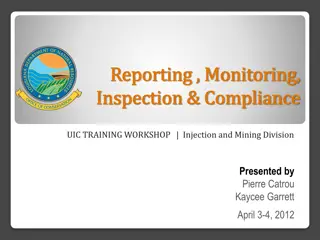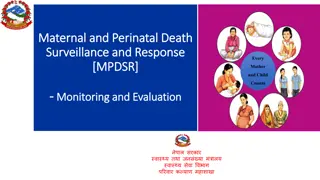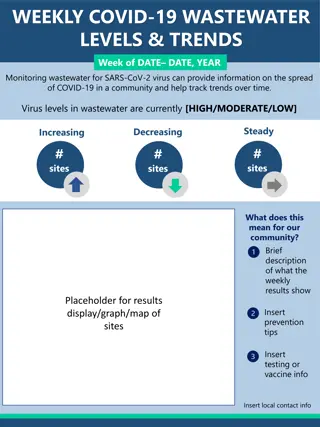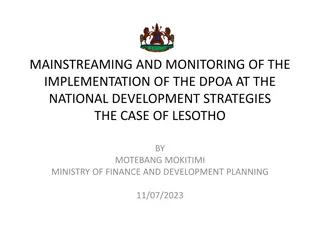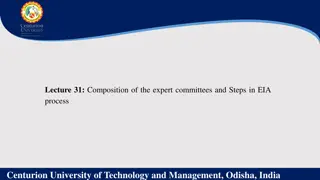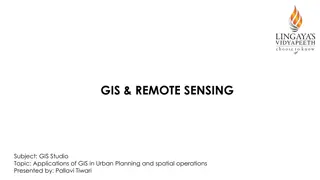Field Study Techniques for Environmental Monitoring
Explore various field study techniques for monitoring environmental factors such as biotic and abiotic elements, canopy cover, humidity, light intensity, and wind direction and speed. Learn how to measure and interpret these parameters effectively using tools like hygrometers, lux meters, compasses, and anemometers to gather valuable data in ecological studies.
Download Presentation
Please find below an Image/Link to download the presentation.
The content on the website is provided AS IS for your information and personal use only. It may not be sold, licensed, or shared on other websites without obtaining consent from the author. Download presentation by click this link. If you encounter any issues during the download, it is possible that the publisher has removed the file from their server.
Presentation Transcript
Biotic & Abiotic Elements Biotic & Abiotic Elements
Canopy Cover Canopy Cover
Canopy Cover Procedure Canopy Cover Procedure
Humidity Humidity Moisture in the air is available for plants. Dense plant communities retain air moisture by inhibiting air movement and evaporation. Measure using a Hygrometer
Humidity Procedure Humidity Procedure Read and record temperature of the wet bulb thermometer in degrees Celsius. Read and record the temperature of the dry bulb thermometer(degrees Celsius). Calculate the difference in temperature readings between the wet and dry thermometers. Use the conversion scale to determine the humidity or interpret the temperature differences: follow down column of correct difference until you reach the current temp on dry bulb. This percentage reading is the current humidity. Record on worksheet.
Amount of Light(Light intensity) Amount of Light(Light intensity) Light is needed for photosynthesis. If the tree canopy is open there is enough light to allow shrubs, grasses and an understorey of trees. When the canopy is closed there is filtered sunlight and consequently the vegetation would include ferns, lichens and mosses. Shrubs would have large leaves. Light is measured using a lux meter
Measuring Light Intensity Measuring Light Intensity Place scale button on x 100. Turn on power. Remove cover from light sensor and hold sensor upwards & flat. If sunny, place sensor in shade and take a reading. Then place in the sun and take a reading. Average the result and multiply this number by 100. Record your Light meter reading result in LUX. If overcast, any situation for the sensor is appropriate.
Wind direction and speed Wind direction and speed These parameters will vary across sites. Use a compass to measure direction Use an anemometer to measure wind speed
Measuring Wind Speed Measuring Wind Speed Turn anenometer on. Select the wind speed icon. Face meter into wind Measure wind direction using a compass Record Wind Speed in kilometres per hour in your booklet
Soil texture procedure Soil texture procedure Soil texture can be estimated by hand, using the ribboning technique, but it takes practice to produce a consistent result. NSW Department of Primary Industries 2015
Soil Soil p pH H This refers to potential hydrogen. Plants require a specific level of pH to grow. Measure using a pH testing kit
Soil Soil p pH Procedure H Procedure Place tiny amount of soil on your tile. Moisten soil with a few drops of Universal indicator Sprinkle Barium Sulphate over dampened soil Wait a few minutes before taking a reading using the pH colour chart
Soil Moisture procedure Soil Moisture procedure Moisture is important for the functioning of an ecosystem. Plants have varying requirements for moisture and there are numerous adaptation for maximizing the use of available water. Insert soil moisture meter carefully to a 15 cm depth Record result.
Slope Slope The slope of the ground is important in determining which plants grow in an ecosystem. The slope of the ground will affect drainage which will then affect soil moisture and depth of soil. Use a clinometer to measure slope
Clinometer procedure Clinometer procedure A clinometer is like a mathematical protractor Stand about 5 metres apart with a partner of similar height up or down the slope Line up the sight on the clinometer with your partners eyes while holding trigger on instrument Once steady release trigger and take/record measurement in degrees.
Aspect Aspect Aspect is the direction a slope faces. The amount of sunlight an area of land receives has a big impact on its microclimate, whether it is warmer or cooler, moister or drier than surrounding areas. Measure using a compass
Procedure to measure Aspect Procedure to measure Aspect using a Compass using a Compass Hold the compass facing up with the tag towards your body. Hold the compass flat and parallel to the ground. Aim the square end of the compass down slope. Wait for the magnetic north needle to stop moving. Turn the round dial to align the North marker with the needle. Read the direction on downhill on the dial. Record the direction as NW, ESE, etc. This direction is the aspect of your slope.
Altitude Altitude The higher the altitude the cooler the temperature, which ultimately has an affect on the plants that can grow in the ecosystem. Measure altitude using a GPS




